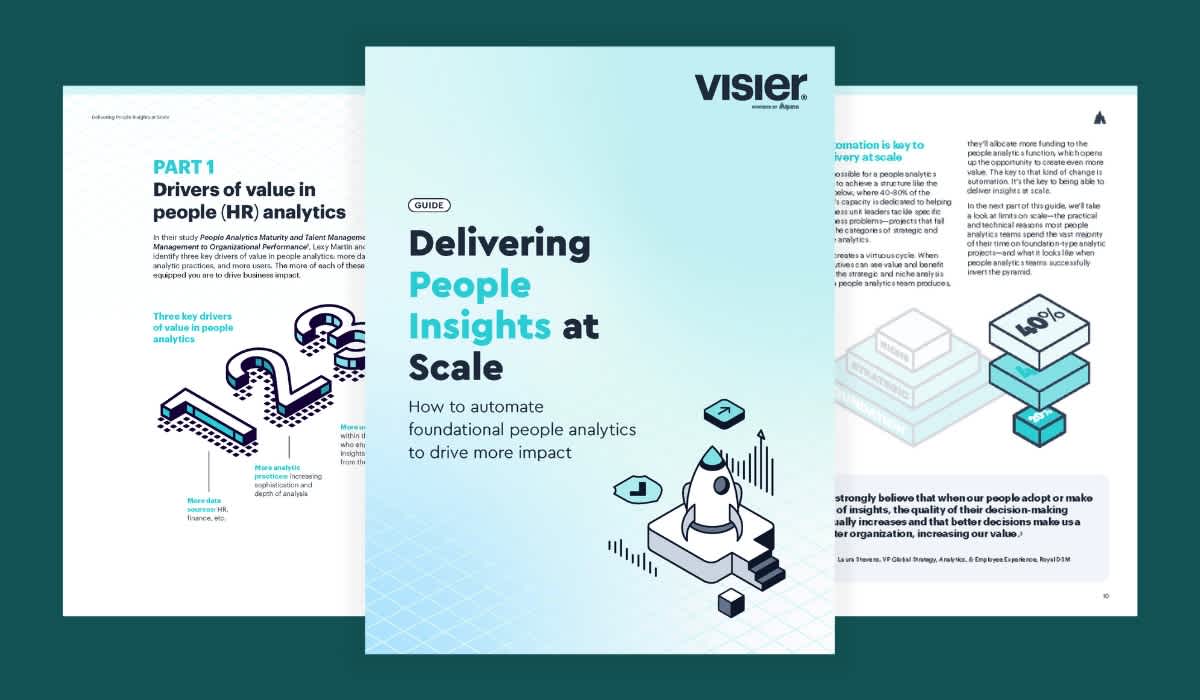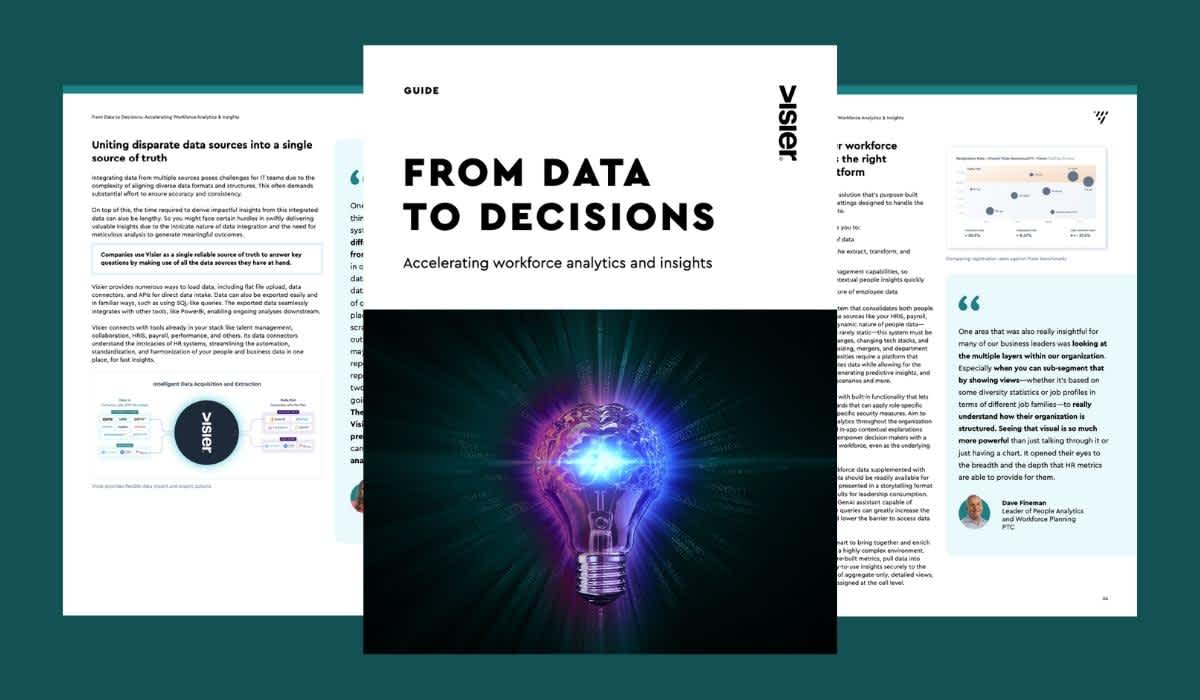How To Find the Right HR Data Warehouse Model for Your Organization
Discover the challenges of relying on multiple HR data warehouses and find the best solution for top data integration and insights.

Almost one-quarter of organizations use eight or more HR solutions at any given point. A single firm can rely on as many as 10 to 15 source systems in its HR tech stack, including human capital management (HCM), human resource information systems (HRIS), employee experience, talent acquisition, learning and development (L&D), and more. To get meaningful insights about employees, HR and business leaders need to be able to combine the data they get from these sources and run reports.
The manual process of extracting, transferring, and loading (ETL) data is painful, costly, error-prone, and time-consuming. With organizations using multiple solutions for different purposes, their data becomes fragmented across these disparate systems. This makes integration harder, as data must be harmonized from various sources. Each source has its own format, schema, and set of data standards.
As a company evolves, the volume and depth of HR data also increase. For instance, manual integration processes that may be enough for smaller-scale operations become increasingly untenable. People data, with its nested, historical, and progressive nature is particularly complex to manage. Once you load additional data, like payroll and performance information, the volume gets big—fast.

Eliminating silos with HR data warehouses
HR data warehouses store employee data from multiple HR systems and sources into one platform. This approach eliminates data silos and provides a comprehensive view of employee performance and progress.
The result? Managers can make better data-driven decisions and spend more time on strategic activities with less manual work. This holistic view allows organizations to gain deeper insights into workforce trends, performance metrics, talent development needs, and more.
Unlike traditional transactional databases which prioritize data storage and transaction processing, HR data warehouses are designed specifically for analytical purposes.
These analytical HR databases are optimized for running complex queries at speed and scale, enabling fast and efficient data retrieval for reporting, analysis, and decision-making. By leveraging the capabilities of analytical databases, organizations can access real-time insights and respond promptly to evolving business needs and workforce changes.
How an HR data warehouse works
An HR data warehouse collects, stores, and organizes vast amounts of employee-related data from various sources within an organization.
The first data collection step is finding the sources of the HR data. For an organization running its own HR data warehouse, these sources include payroll systems, HCM platforms, performance management tools, learning management systems (LMS), and recruitment software.
For an HR tech vendor running analytics on their application data, data sources could include disparate modules within their application suite.
The next step is extracting data from each source. This process may vary depending on the source system and the available integration methods. Some systems provide APIs (application programming interfaces) or prebuilt connectors for data extraction, while others may require manual export or batch processing.
Once the data is extracted and transformed, it is stored in the HR data warehouse. This warehouse holds structured data about employees and is designed for large-scale querying and analysis, such as using analytics or generative AI to provide insights about the workforce.

Data management involves continuous monitoring and management of data quality. This ensures the data warehouse adheres to strict security protocols and complies with data protection laws. At this stage, you'll want to look into regularly monitoring data quality by conducting ongoing assessments to identify any issues or anomalies.
Data management practices further include data cleansing and enrichment techniques to improve the quality of the data stored in the warehouse. This may involve removing duplicate records, fixing errors, standardizing formats, and adding attributes or metadata to enrich the data to make the information more useful and relevant.
People data warehouses also provide the capability to analyze stored data, supporting both predefined reports (like turnover rates) and custom analytical queries for deeper insights. Such reports provide quick and easy access to commonly requested information, allowing users to track and monitor HR metrics in real time.
For more sophisticated analytics, HR data warehouses integrate with external business intelligence (BI) tools, enabling data science applications on HR data. HR professionals can use these advanced analytics features to perform predictive modeling, identify patterns, forecast trends, and make data-driven predictions about workforce behavior and outcomes.
Three types of HR Data Warehouses
There are three main types of HR data warehouses, each tailored to meet the specific needs and requirements of organizations. Let’s explore the intricacies behind each and when to best use them.
1. DIY HR data warehouse
Also known as "build it yourself". When you’re building a custom people data warehouse, you’re in charge of designing, building, and maintaining it. This involves a range of skill sets, from data architecture to software development to DevOps.
Best for: Teams with small people analytics needs that won’t scale over time. You’ll need additional resources to commit to development and maintenance. These can get expensive as you scale because your analytical needs naturally grow as your company expands or goes through restructuring.
Pros | Cons |
|---|---|
Customization: Tailor-made to adapt the system to your organization's unique requirements, enhancing efficiency and productivity. | Resource intensive: Requires significant time, expertise, and ongoing maintenance that can strain budgets and personnel, not just in the area of custom software development, but also in designing and modeling data around employees. |
Control: Complete control over the data infrastructure and security measures ensures compliance, protecting sensitive information, and maintaining trust among stakeholders. | Scalability issues: Can hinder adaptability to organizational growth and evolving data complexities, potentially leading to inefficiencies and limitations. |
Longer time to value: The time from starting development to obtaining actionable insights can be lengthy. This means delayed benefits and insights, impacting decision-making and competitiveness. | |
Technical debt: This can impede future developments and upgrades, necessitating efforts to mitigate its effects. | |
Documentation: Thorough documentation becomes crucial to maintain continuity and knowledge transfer, especially if key developers depart. | |
Higher security risks: Very sensitive data demands stringent measures to ensure robust protection and compliance. |
2. Generic data warehouse
Don’t have the time to build your own warehouse (like most)? You can opt for cloud-based data warehousing solutions such as Snowflake or Amazon RedShift that serve a wide range of industries and functions.
Best for: Companies storing their business data in an existing people data warehouse, only need basic analytics capabilities, and don’t plan on delivering insights across the organization.
Pros | Cons |
|---|---|
Easy infrastructure setup: These platforms provide quick setup times and managed services that streamline the onboarding process, reducing time-to-deployment and minimizing initial setup complexities. | Generic features: While generic platforms offer flexibility, they lack the specialized data models and metrics needed for HR analytics, which you have to build yourself. People often underestimate how complex people analytics is, and find themselves in a tricky situation when they’ve gone over budget and aren't able to deliver what HR needs. |
Scalability: Platforms designed for scalability can automatically adjust resources based on demand, ensuring smooth operations even during periods of high traffic or increased workload. | Poor security: Inadequate security measures pose significant risks, especially when dealing with sensitive people data. Generic databases lack granular access controls, potentially exposing confidential information like birth dates or Social Security Numbers (SSN) to users who shouldn't have access. Without column-level access control, the risk of unauthorized access or data breaches increases, leading to legal and reputational consequences. |
Diverse integration opportunities: With a broad ecosystem for integrating various data sources and tools, these platforms facilitate seamless connectivity and interoperability, enhancing data accessibility and analysis capabilities. | A problematic learning curve: Effectively using these platforms requires not only technical proficiency but also a deep understanding of people analytics principles and practices. Addressing this learning curve may involve investing in training and development initiatives for personnel responsible for managing and customizing the database. |
Convenience: Through existing infrastructure, companies can easily expand their data capabilities without introducing significant disruptions or the need for extensive retraining. This simplifies adding new data and functionalities to the existing stack, promoting continuity and efficiency. | Snapshot-in-time: Most data warehouses contain data that focuses on the “now” vs. historical data. The latter is crucial for understanding trends, patterns, and changes over time, which is fundamental to effective people analytics. Instead, if a generic data warehouse contains historical data, it’s often stored in timestamped tables. This can become hard to manage, challenging to query, and expensive to store over time. |
Lacks visualization capabilities: Your data analysts will most likely be querying your people data warehouse using BI tools like Power BI, Tableau, ClickView, or Looker. They’d only create dashboards for use across the business using this basic data. Revising these dashboards or creating new data visualizations to support evolving business requirements can be time-consuming and costly, since it requires coordination between data analysts, business stakeholders, and IT teams. |

3. Purpose-built HR data warehouse
Purpose-built HR data warehouses are specifically designed for people analytics, offering out-of-the-box functionality tailored to HR data management and analysis needs.
Best for: Teams that don’t have internal people analytics expertise. You might also consider them if you don’t want—or don’t have the time—to build and maintain your own HR data warehouse model.
Pros | Cons |
|---|---|
Built for HR-specific use cases: Purpose-built HR data warehouses come with prebuilt data models, relationships, visualizations, and metrics specifically designed for people analytics needs. This means organizations can leverage ready-to-use analytics solutions right after connecting their HR data sources. This reduces the time and effort needed for customization. | Less flexibility: While highly tailored to HR, these data warehouses offer less flexibility than a DIY solution built for unique organizational needs. However, best-of-breed HR data warehouses allow you to customize the underlying model so you can incorporate data from non-HR sources for in-depth business insights. |
Equipped to handle historical, time-based analysis of people data: With people as the main subject of analysis, a purpose-built HR data warehouse is designed to take into account the timeline of any employee. Specifically, timelines follow their unique journey within an organization—from the employee's application, to offer, promotion, PTO, recognition, and termination. | More difficult integration opportunities: There might be initial concerns about integrating the HR data warehouse with existing systems and data sources within the organization. However, leading HR data warehouses prioritize seamless integration capabilities with a wide range of HR systems and data formats. This can ensure a smooth transition and comprehensive data cohesion. |
Strong security measures: A purpose-built security model is formed around the intricacies of people, taking into account aspects such as their job role, access levels, and cell and column-level security (e.g. exposing employee names to all users, but restricting birth date and SSN only to the HR team). It should also allow for dynamic role assignments as employees move around. | |
Faster time to insight: Ready-to-use integrations and analytics capabilities shorten the time you need to go from data collection to decision. | |
User-friendly interface: Designed for both HR professionals and data engineers, these purpose-built platforms reduce the need for specialized training and setup. | |
Easy to scale: With self-serve analytics in your plan, a purpose-built HR data warehouse is in a far better place to support this. Best-of-breed solutions come with pre-built data visualizations and explanations. This means that HR and non-HR users can better consume the insights and make informed decisions faster. | |

Visier journey timeline example
Uniting your HR data warehouse and people analytics
Visier’s People Data Platform stands as the pinnacle of people analytics software, trusted by over 55,000 companies worldwide, representing more than 25 million employees. Visier serves as your HR data warehouse and offers an intuitive front-end visualization layer, empowering you to deploy people insights accross the organization.
Whether you’re a company looking to deploy people analytics across the board or an HR tech vendor looking to embed world-class analytics and genAI inside your app, Visier’s people data warehouse serves as the foundation by which your data can be modeled and stored for meaningful insights, regardless of how they’re delivered.
Visier's security model prioritizes the protection of sensitive HR data, while ensuring accessibility and compliance. Visier encrypts data both in transit and at rest using industry-standard encryption protocols to safeguard data confidentiality.
Role-based access controls restrict data access to authorized users based on their roles and responsibilities, ensuring that individuals only have access to the data necessary to perform in for their job. The platform also implements data isolation techniques to prevent unauthorized access and adheres to strict data privacy regulations and best practices.
Reduce build time, lower TCO, and deliver the insights your stakeholders need. Experience how Visier operates as your HR data warehouse and much more by signing up for a 30-day free trial.



